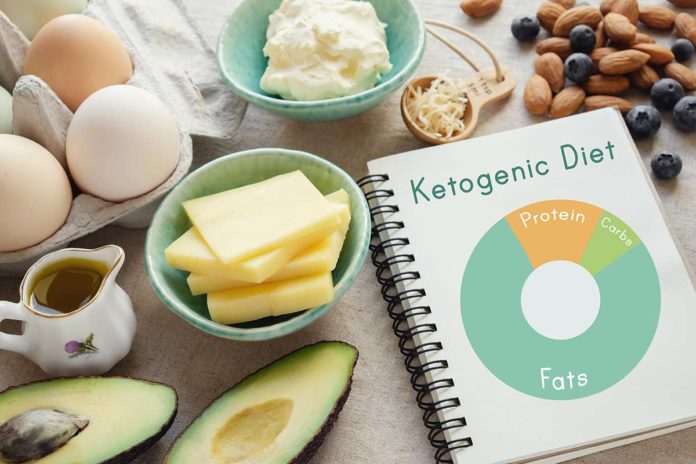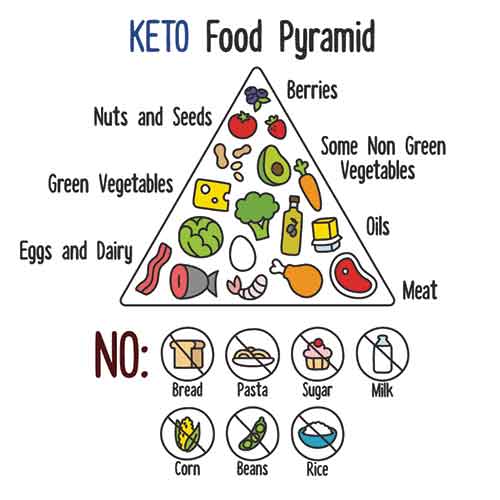A keto or ketogenic diet is a very low-carb, high protein and fat diet, which turns the body into a fat-burning machine. It has many proven benefits for weight loss, health, and performance. This dieting technique has been followed by many since the 1920s; it is based upon the understanding of the human physiology and nutritional intake science. It’s said to work for most as it targets several underlying causes of weight gain – which includes hormonal imbalances, insulin resistance coupled with high blood sugar levels and, the cycle of restricting and binge eating of empty calories.
What Is Ketosis?
When you eat something high in carbs, your body will break down the compound into glucose and insulin. Glucose is used as primary energy; your fats are not needed and are therefore stored. Typically, on a normal higher carbohydrate diet, the body will use glucose as the main form of energy. By lowering the intake of carbs, the body is induced into a state known as ketosis. Ketosis is a natural process the body initiates to help us survive when food intake is low. During this state, we produce ketones, which are produced from the breakdown of fats in the liver.
- Starchy foods like bread, pasta, rice, and potatoes.
- Vegetables growing below ground contain more carbs; some examples would be sweet potatoes, carrots, turnip, etc.
- Fruits other than berries are usually avoided during this diet, as all fruits contain carbohydrates – sugar which gives it the sweetness.
- Nuts like cashews and pistachios.
- Beans or legumes like peas, kidney beans, lentils, chickpeas, etc.
Working Out During The Keto Diet:
By now it can be understood that a keto diet allows you to have very few carbs, however, the body does need some amount of carbs during certain types of exercise. You cannot cut out carbs fully from your diet if you have an active workout regime. For, your body will need the carbs as an initial energy boost. There is no need to worry though; your body is still going to burn through the carbs quickly so that little extra carb consumption will not have much of an impact on your keto progress.

Ketogenic diets are designed to help you lose fat. But just following the diet will not aid you in the results you seek; working out is going to help you lose weight and, in most cases, working out consistently while eating the right foods will help you lose fat. One of the root causes of fat loss during the keto diet is that you eat less due to low carb diets which have an appetite lessening effect on your body. It is also said that as we increase in age, our body’s metabolic rate decreases and the importance of maintaining a healthy weight increases. Worry not though, with the right type of exercise you are sure to increase muscle mass, which in turn will help you burn more calories.

According to the type of keto diet you follow, weight training or exercise schedules can be classified into four types, they are:
- Aerobic Exercise (CARDIO), also known as cardio exercise, is anything that lasts over three minutes. This workout regime is low intensity, keeping up steady-state cardio for fat burning, and making it a very friendly exercise regime for the keto dieter.
- Anaerobic Exercise (Weight Training/HIIT/HIIE), is characterised by shorter bursts of energy, whether it is weight training or high-intensity interval training. These two methods are the best tools for fat loss with the gain of muscle mass. Weight Training: It focuses on major muscle groups and helps you build lean muscle. High- Intensity Intermittent Training/Exercise: This technique is carried out with alternating intervals of high-intensity exercises, which could be sprinting or running with shorter intervals of rest periods.
- Flexibility Exercises are helpful for stretching out your muscles, supporting joints, and improving muscle range of motion. Increasing your flexibility can help prevent injuries caused by the shortening of the muscles over time. Yoga and simple after-workout stretches are good examples of this.
- Stability Exercises include balance exercises and core training. They help improve your alignment, strengthen muscles, and control movement


